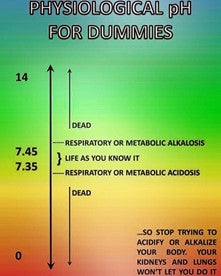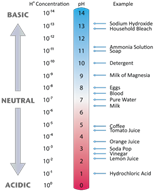I think most of us understand by now that fad diets never seem to do what they claim. They come and go, leaving a wake of people for whom it didn’t work searching for the next quick fix.
It’s no longer a secret that the long term success rate for fad diets just isn’t great, but another more insidious outcome of fad diets is leaving people with a complete misunderstanding of some pretty basic chemistry and physiology concepts. Enter the alkaline diet. I’ve never seen a fad diet create such a misunderstanding of basic chemistry concepts, such as pH, and some pretty basic physiology concepts as well.
The alkaline diet was popularized by Robert O. Young, who claimed that the human body is alkaline by design and acidic by function, and that there is only one disease (acidosis) and one treatment (an alkaline diet).
Unfortunately, the diet lives on despite the fact that his claims make entirely no scientific sense, in addition to the fact that Young was a complete fraud. He was arrested in 2014 and received 18 felony charges relating to practicing medicine without a license, and of theft. In February 2016, jurors found Young guilty of two counts of practicing medicine without a license. In 2017, Young pleaded guilty to two more counts of practicing medicine without a license. Young declared that he has no degrees from any accredited schools, and that he is not “a microbiologist, hematologist, medical doctor, naturopathic doctor, or trained scientist.” In November 2018 he was ordered to pay $105 million to a cancer patient who had sued him for claiming to be a doctor and advising her to forgo traditional medical treatment.
The entire premise of this diet defies basic physiology. The foods we eat do not affect the pH of our bodies because pH is tightly regulated by many different mechanisms to ensure that it stays constant.
The main way our bodies regulate pH is through the bicarbonate buffer system that exists in our blood. Buffers strongly resist changes in pH despite the addition of acidic or basic chemicals. The buffer system in our blood maintains a tight pH range between 7.35-7.45 despite the addition of large amounts of acidic or alkaline substances.
Altering respiratory rate (breathing) affects the system by adding or eliminating carbon dioxide. If the blood gets too acidic (acidosis) respiratory rate increases to bring the pH back up, and if the blood gets too alkaline (alkalosis) respiratory rate can decrease so more carbon dioxide can dissolve into the blood.
Not to mention the fact that our stomach acid maintains a pH of around 2, so alkalinity doesn’t matter much once it reaches the stomach. Any food or water entering the stomach is acidified by these gastric juices in which the low pH is important for digestion. In addition, our kidneys produce urine that is more or less acidic to help balance pH, so don’t fall for the urine tests that purport to show how alkaline your body is. That is not a measurement of the pH of your body. The addition of acidic or alkaline food to our body doesn’t affect the pH of our bodies in any meaningful way, luckily, because if it did we would die!

The alkaline diet has not only caused its supporters to believe and spread misinformation about basic physiology, but chemistry as well. I just posted a video from TikTok the other day where someone was claiming that cucumbers and bananas are “100 percent alkaline.” Just from a very basic chemistry standpoint this makes entirely no sense. pH is a unit of measurement which represents the concentration of hydrogen ions in a solution. The pH scale generally ranges from 0-14.

Aqueous solutions at 25°C with a pH less than 7 are acidic, a pH level of 7 is defined as “neutral” and those with a pH greater than 7 are basic or alkaline. Very strong acids might have a negative pH, while very strong bases might have a pH greater than 14, but when we’re talking about substances we ingest, we’re generally talking as low as a pH of around 2 for something like lemon juice up to a pH of around 8 for something like baking soda. So, you can see how claiming that anything is 100 percent alkaline just makes no sense, but in addition to that, cucumbers are at a pH of around 6 and bananas are around a pH of 5, so they aren’t even alkaline.
It seems like “alkaline” has just become a word that the alkaline diet crowd uses for what they would otherwise deem “healthy” or “good,” while “acidic” foods are just foods they deem “unhealthy” or “bad” regardless of the actual pH of the food. So, the entire premise of the diet just makes absolutely no scientific sense and further confuses people about what pH and “alkaline” actually mean.
The misinformation is further perpetuated by those selling thousand-dollar alkaline water machines and alkaline bottled water as well. Save your money, not just for the above reasons, but due to the lack of evidence on it too. Not only are these bottled waters not even necessarily at the pH advertised, but the health benefits they claim aren’t backed by the evidence either.
There is, however, one exception to the conclusion that there is no plausible benefit from drinking alkaline water, and that is for acid reflux. Drinking alkaline water could have therapeutic benefits for patients with reflux disease, and there is some evidence to support that, however, there are no studies of actual efficacy in humans.
If someone is making money off of pushing a diet or a product that claims everything from weight loss to curing cancer, that’s a huge red flag. The diet itself isn’t necessarily unhealthy or harmful, as it likely contains a lot of fruits and vegetables, but what can be harmful is forgoing necessary medical treatments due to the promise of a miracle diet.
An understanding of some pretty basic science concepts can often help you to spot this kind of food pseudoscience. If it seems too good to be true, it usually is!
Food Science Babe is the pseudonym of an agvocate and writer who focuses specifically on the science behind our food. She has a degree in chemical engineering and has worked in the food industry for more than decade, both in the conventional and in the natural/organic sectors.



